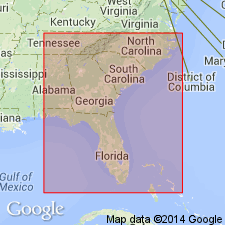
- Usage in publication:
-
- Pinecrest beds
- Modifications:
-
- Original reference
- Dominant lithology:
-
- Sand
- AAPG geologic province:
-
- Florida platform
Summary:
Pg. 511-526. Pinecrest beds. Name applied to unit overlying Tamiami formation and underlying Caloosahatchee marl. Largely fine quartz sand 10 to 20 feet thick. Formation has much the appearance of a beach deposit and worn flat disk-shaped quartz pebbles are plentiful at some places. Locally, Pinecrest beds in type area may be fossiliferous, carrying predominantly a pelecypod assemblage in which MACROCALLISTA REPOSTA (Conrad) are most numerous. Age is late Miocene and Pliocene.
Recognized in southern Florida. Encountered directly below a surface limestone in general region of the 40-mile bend on Tamiami Trail (Route 1) west of Miami in western part of Dade County and extending across its boundary into Collier County. Name taken from an old settlement on Everglades road (which branches off from the present highway at 40-mile bend) about 1 mile from west of Dade-Collier County line, [Miami quadrangle (scale 1:250,000), 1956 ed.]. Largest known area of beds in shallow subsurface extends through parts of Glades, Highland, and Hendry Counties, north and northwest of Lake Okeechobee.
[Pinecrest (site) located on Loop Road (Route 94), Tamarind Hammock, west of Fortymile Bend, Lat. 25 deg. 44 min. 48 sec. N., Long. 80 deg. 56 min. 22 sec. W., in northernmost part of Lostmans Trail 7.5-min quadrangle, Monroe Co., Big Cypress National Preserve (from USGS GNIS database, USGS historical topographic map collection TopoView; accessed February 19, 2014).]
Source: US geologic names lexicon (USGS Bull. 1350, p. 578).
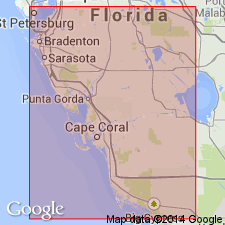
- Usage in publication:
-
- Pinecrest sand member
- Modifications:
-
- Revised
- AAPG geologic province:
-
- South Florida province
Summary:
Raised the Pinecrest beds to Pinecrest sand member of the Tamiami formation. Overlies Murdock Station member; underlies Buckingham limestone member.
Source: GNU records (USGS DDS-6; Reston GNULEX).
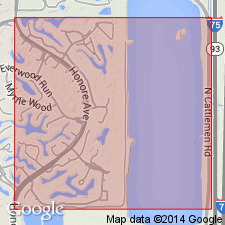
- Usage in publication:
-
- Pinecrest Beds
- Modifications:
-
- Revised
- AAPG geologic province:
-
- South Florida province
Summary:
Formalized usage of Pinecrest Beds and described units. Consists mainly of sand and fossil beds.
Source: GNU records (USGS DDS-6; Reston GNULEX).
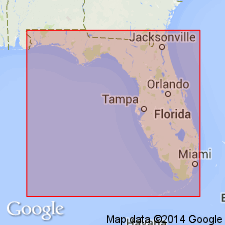
- Usage in publication:
-
- Pinecrest Sand Member
- Modifications:
-
- Overview
- AAPG geologic province:
-
- Florida platform
Summary:
One of 9 facies of Tamiami Formation. The problem with the definition of the Pinecrest fauna as a member of the formation is that presence of a faunal type does not define a sediment facies or specific lithic unit. Also, it occurs only in isolated small areas separated by large distances. It is not continuous between areas where the section has been measured and described. It occurs in Charlotte Co., along Alligator Alley in Collier Co., in Dade Co., and in a few areas north of the Big Cypress Indian Reservation in Hendry Co. In 1987, Meeder (Ph.D. dissertation) described a reefal limestone facies containing Pinecrest fauna in Collier and Lee Cos. and called the unit the Golden Gate Member of the Tamiami Formation.
Source: GNU records (USGS DDS-6; Reston GNULEX).
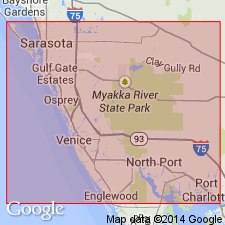
- Usage in publication:
-
- Pinecrest†
- Modifications:
-
- Abandoned
- AAPG geologic province:
-
- Florida platform
Summary:
Name Fruitville Formation here proposed to replace preoccupied Pinecrest Formation of Olsson (1964). Type section designated in Macasphalt Shell Pit, 5 mi east of Sarasota. Pinecrest was originally named on the basis of fossils collected from excavation spoils over a wide area of southern FL rather than an actual stratigraphic section. Age of the Fruitville is Pliocene, constrained to between 5 and 1.9 Ma.
Source: GNU records (USGS DDS-6; Reston GNULEX).
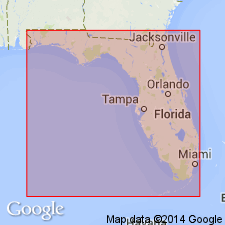
- Usage in publication:
-
- Pinecrest beds
- Modifications:
-
- Revised
- AAPG geologic province:
-
- Florida platform
Summary:
Petuch (1986) suggested using the name Buckingham Formation for the unit called Pinecrest as that name was preoccupied, but unit is lithologically incompatible with the typical Buckingham Limestone of the type are in Lee Co. Authors in this report prefer to use the name Pinecrest beds in an informal sense.
Source: GNU records (USGS DDS-6; Reston GNULEX).
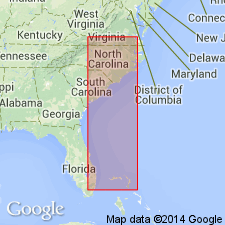
- Usage in publication:
-
- Pinecrest Beds*
- Modifications:
-
- Biostratigraphic dating
- Geochronologic dating
- Paleomagnetics
- AAPG geologic province:
-
- South Florida province
Summary:
Pinecrest Beds of peninsular Florida were assigned a middle to late Pliocene age by DuBar (1974) (who referred to these rocks as the Pinecrest Sand Member of the Tamiami Formation). Hazel (1977 and personal commun., 1990) dated the uppermost beds of the Tamiami and the overlying Pinecrest Beds as early and middle Pliocene based on zone 20 planktonic foraminifers and ORIONINA VAUGHANI and PARACYTHERIDEA MUCRA ostracode assemblage zones. In southwest FL, samples of Pinecrest from APAC pit east of Sarasota were studied. Jones and others (in press) concluded that beds 5 to 10 (of Petuch, 1982) were equivalent to middle Pliocene of other Coastal Plain regions. Strontium ratios for mollusks gave the entire Pinecrest section an age of 4.5 to 1.8 Ma and for beds 3 and 4 an age of 2.4 to 1.8 Ma (approx.). Paleomagnetic data suggest that beds 2 through 4 are in the lower part of the Matuyama Chron, an age supported by late Blancan (2.5-2.0 Ma) vertebrate assemblage in unit 4. Beds 5 to 10 (lower part of Pinecrest) contain ostracode assemblages corresponding to PARACYTHERIDEA MUCRA assemblage (Cronin, 1981) which is dated by nannofossils and planktonic foraminifers as 3.5-3.0 Ma. Bed 10 yields DISCOASTER TAMALIS which constrains the age to a maximum of 3.8 Ma and a minimum of 2.6 Ma. Most samples in this study are 3.5 to 3.0 Ma, but beds 3 and 4 may be younger. Correlation chart shows age as early and late Pliocene.
Source: GNU records (USGS DDS-6; Reston GNULEX).
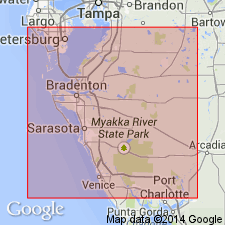
- Usage in publication:
-
- Pinecrest Beds*
- Modifications:
-
- Overview
- Biostratigraphic dating
- AAPG geologic province:
-
- Florida platform
Summary:
Report uses Pinecrest Beds of Tamiami Formation of southwestern FL. Strata in the Quality Aggregate Phase 6 Pit, APAC Shell Pit, and DeSoto No. 5 Pit include units 10, 8, 7, 6, 3, and 2 of Petuch (1982). Unit 10, the lowest in Pinecrest Beds, is a MERCENARIA biofacies overlain unconformably by unit 8, which is a VERMICULARIA biofacies. Units 6 and 7 contain best-preserved and most diverse assemblages of fossils within Pinecrest Beds. Unit 7 is characterized by a mixed shell assemblage and unit 6 contains a mixture of HYOTISSA and other shells. Unit 3, a mytilid layer, unconformably overlies unit 6. Unit 2 is a HYOTISSA bed. All are part of Pinecrest Beds. Younger samples collected at DeSoto, where lowest sample studied has typical Caloosahatchee Formation molluscan fauna (L. Wingard, 1992, personal commun.) are tentatively assigned to the Caloosahatchee.
Source: GNU records (USGS DDS-6; Reston GNULEX).
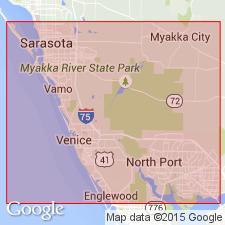
- Usage in publication:
-
- Pinecrest beds
- Modifications:
-
- Overview
- AAPG geologic province:
-
- Florida platform
Summary:
The nomenclature of the Pliocene Tamiami Formation applied in this report evolved from the stratigraphic revisions of Hunter (1968) and those of Petuch (1982). Formation is divided into lower and upper parts. The lower part includes units 11 and 10 of Petuch and is equivalent to the Murdock Station Member of Hunter. The upper Tamiami includes Petuch's units 9 through 2 and is essentially equivalent to Hunter's Pinecrest Member. The upper Tamiami is further subdivided into lower and upper Pinecrest beds at an unconformity that is observed between units 4 and 3 in quarry exposures in Sarasota Co. The lower Tamiami and lower Pinecrest beds of the upper Tamiami of southern FL correlate with the Jackson Bluff Formation of the FL panhandle, and are assigned to the Coastal Onlap Cycle TB3.6 (Zullo and Harris, 1992). This cycle spans the Zanclean-Piacenzian boundary. The upper Pinecrest beds are assigned to the TB3.7 cycle and are Piacenzian in age.
Source: GNU records (USGS DDS-6; Reston GNULEX).
For more information, please contact Nancy Stamm, Geologic Names Committee Secretary.
Asterisk (*) indicates published by U.S. Geological Survey authors.
"No current usage" (†) implies that a name has been abandoned or has fallen into disuse. Former usage and, if known, replacement name given in parentheses ( ).
Slash (/) indicates name conflicts with nomenclatural guidelines (CSN, 1933; ACSN, 1961, 1970; NACSN, 1983, 2005, 2021). May be explained within brackets ([ ]).

